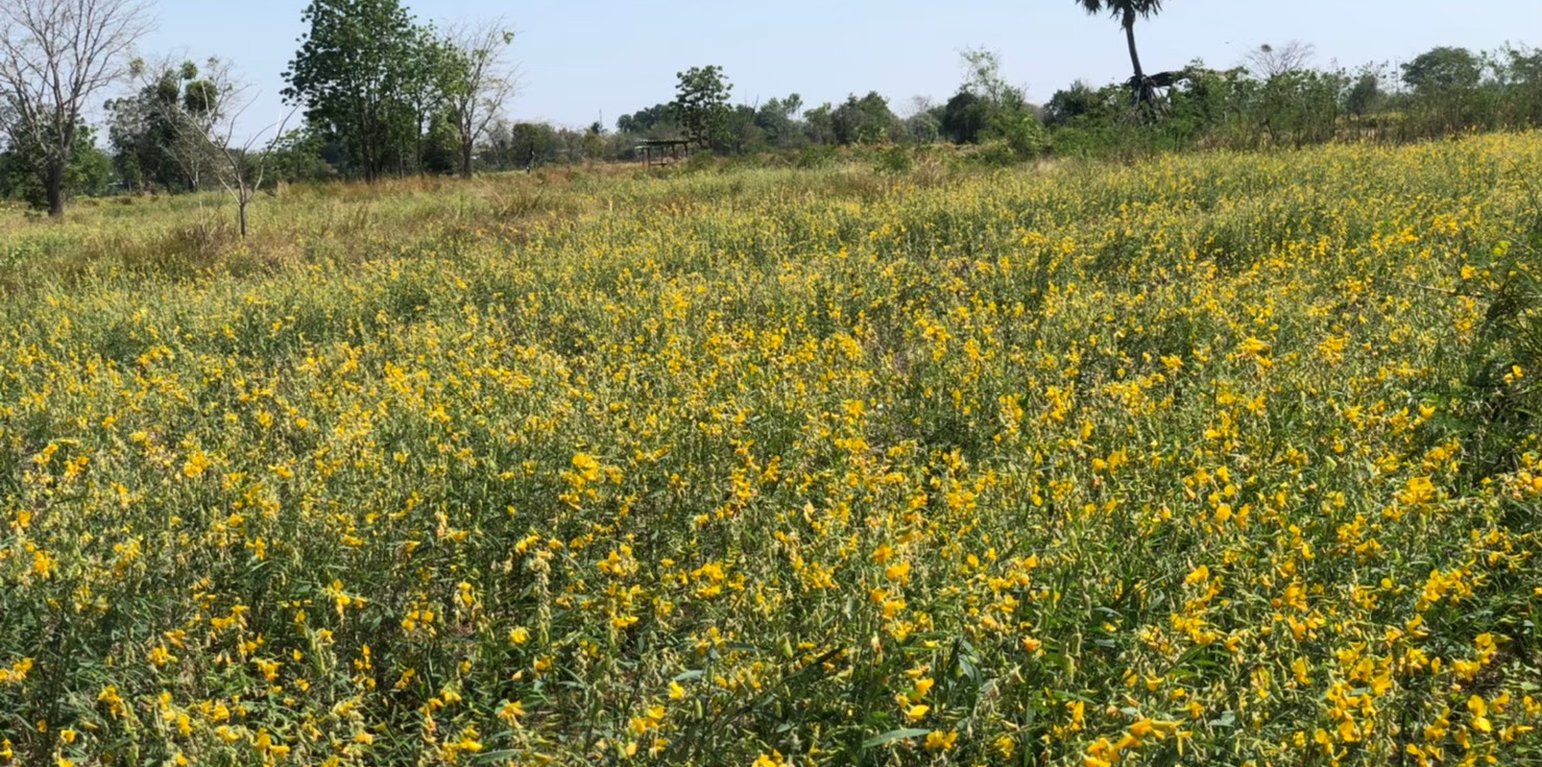



The Northeast of Thailand has the largest area dedicated to rice production in the country. However, the average yield per hectare remains low. Here, rice production heavily depends on rainfall, but distribution is inconsistent. Additionally, soil fertility is low, with a rapid decline in soil organic matter (SOM). Another significant threat to productivity in this area is salinity, with 17% of the rice production area affected.
The Land Development Department (LDD) of the Ministry of Agriculture and Cooperatives has promoted the use of soil amendments, such as green manure plants - including sunn hemp (Crotalaria juncea) - to enhance organic matter and restore soil fertility under saline conditions. Green manures are ploughed under, and incorporated into the soil to achieve their effect.
In the Non Thai district of Nakhon Ratchasima province, farmers face water shortages during the dry season, as the area lies outside the irrigation zone. Farmers, along with officers from the Land Development Department, have worked to increase SOM in degraded soils through knowledge transfer. Volunteer soil doctors and local farmers have adopted technologies that combine SOM improvement with soil and water conservation measures.
One notable example is Mr. Mana Siangsuthia: since 1997, he has collaborated with LDD officers, receiving beneficial microorganisms (PD microorganisms), green manure plants, vetiver grass, and water resources for his paddy fields. He has implemented LDD guidelines to develop his 1.12 hectare rice plot. Previously, this land was unproductive due to soil degradation caused by long-term monoculture of industrial crops and excessive use of synthetic fertilizers.
Fermented bio-extracts from banana shoots and chemical fertilizers were applied according to recommended guidelines. In 2004, rice yields averaged 1,125–1,550 kg/ha. Continuous implementation of these practices raised yields to 2,500 kg/ha by 2011. Over 16 years, using sunn hemp as a soil amendment significantly improved soil aggregate stability and reduced salinity. This success led to a shift towards natural agriculture practices in 2013, where chemical fertilizers were no longer used.
Farmers in the area now employ weather observation techniques and efficient water management strategies during dry spells. Green manure plants are sown every two years, complemented by the cultivation of salt-tolerant rice varieties, which also exhibit drought and pest resistance. These practices have resulted in rice yields of 3,125–3,750 kg/ha.
After rice harvesting, rice straw and stubble are ploughed in together with banana shoot PD 2 bio-extract. After approximately 2 weeks of decomposition, sunn hemp is sown at the rate of 31.25 kg/ha. When sunn hemp reaches 120 days, its seeds are collected. Then sunn hemp stems of around 1.2 meters height are ploughed in order to obtain more biomass.
Water conservation remains a focus in the cultivation area. During the rainy season, excess rainwater is stored for use during dry periods. Additionally, farmers employ techniques to wash salt from the soil surface into drainage channels. Water quality is enhanced using fermented bio-extracts, ensuring adequate water for dry-season cultivation.
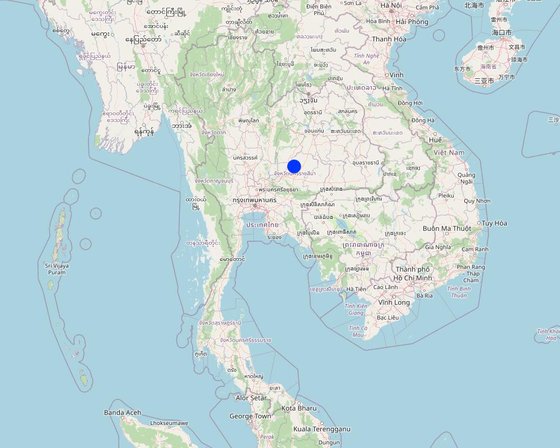
ទីតាំង: Moo 5, Ban Kok Phrom, Non Thai sub-district, Non Thai district, Nakhonratchasima, ប្រទេសថៃ
ចំនួនទីកន្លែងបច្ចេកទេស ដែលវិភាគ: មួយកន្លែង
ការសាយភាយនៃបច្ចេកទេស: ត្រូវបានផ្សព្វផ្សាយត្រឹមតំបន់មួយ (11200.0 km²)
តើស្ថិតក្នុងតំបន់ការពារអចិន្ត្រៃយ៍?: ទេ
កាលបរិច្ឆេទនៃការអនុវត្ត: 1999; 10-50 ឆ្នាំ
ប្រភេទនៃការណែនាំឱ្យអនុវត្តន៍៖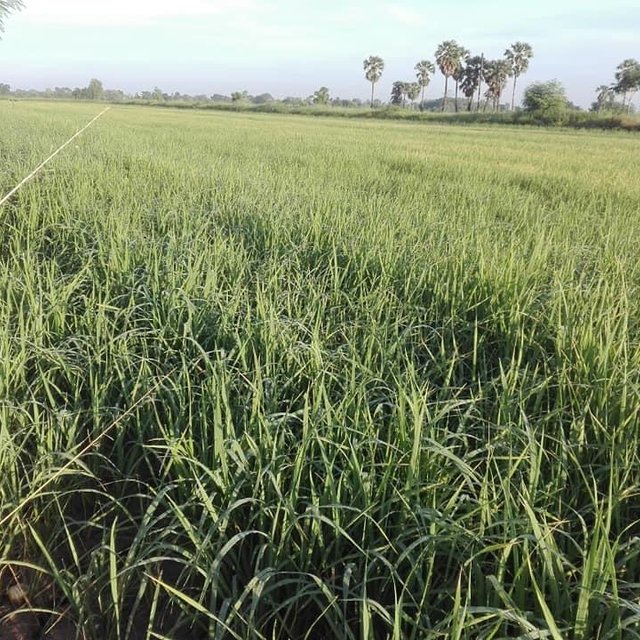
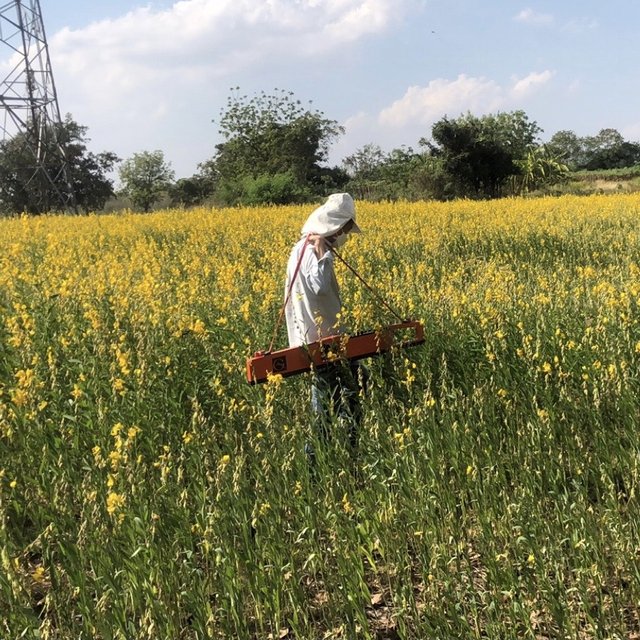




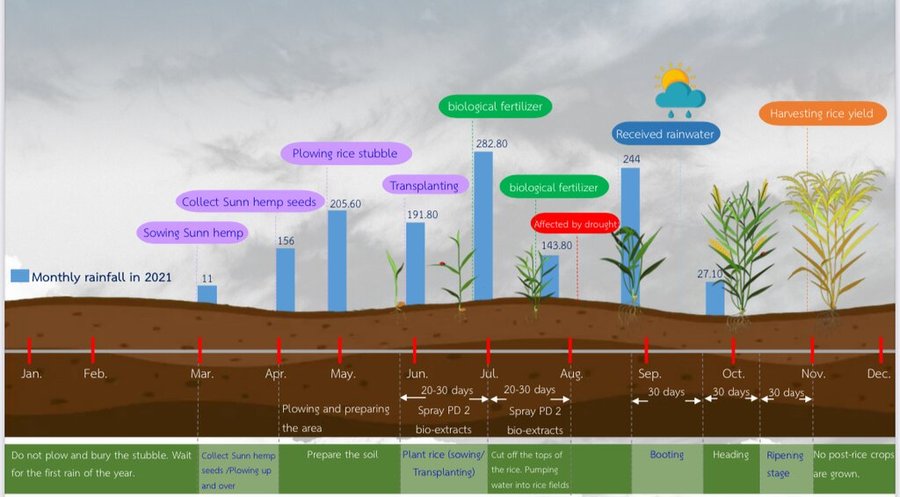
| បញ្ជាក់ពីធាតុចូល | ឯកតា | បរិមាណ | ថ្លៃដើមក្នុងមួយឯកតា (ដុល្លារ) | ថ្លៃធាតុចូលសរុប (ដុល្លារ) | % នៃថ្លៃដើមដែលចំណាយដោយអ្នកប្រើប្រាស់ដី |
| កម្លាំងពលកម្ម | |||||
| សម្ភារៈដាំដុះ | |||||
| ជី និងសារធាតុពុល | |||||
| ផ្សេងៗ | |||||
| បញ្ជាក់ពីធាតុចូល | ឯកតា | បរិមាណ | ថ្លៃដើមក្នុងមួយឯកតា (ដុល្លារ) | ថ្លៃធាតុចូលសរុប (ដុល្លារ) | % នៃថ្លៃដើមដែលចំណាយដោយអ្នកប្រើប្រាស់ដី |
| កម្លាំងពលកម្ម | |||||
| Plow to prepare plots | Time | 1,0 | 14,71 | 14,71 | 100,0 |
| Sow rice | Time | 1,0 | 17,65 | 17,65 | 100,0 |
| Pump water | Time | 2,0 | 58,82 | 117,64 | 100,0 |
| Harvest yield | Time | 1,0 | 183,82 | 183,82 | 100,0 |
| សម្ភារៈដាំដុះ | |||||
| Rice seeds | Kilogram | 8,0 | 0,53 | 4,24 | 100,0 |
| ជី និងសារធាតុពុល | |||||
| Weight | Liter | 40,0 | 0,29 | 11,6 | 100,0 |
| Green Manure | Kilogram | 5,0 | 0,68 | 3,4 | 100,0 |
| ផ្សេងៗ | |||||
| Oil costs for farm truck | Time | 1,0 | 58,82 | 58,82 | 100,0 |
| ថ្លៃដើមសរុបសម្រាប់ការថែទាំដំណាំតាមបច្ចេកទេស | 411.88 | ||||
| ថ្លៃដើមសរុបសម្រាប់ការថែទាំដំណាំតាមបច្ចេកទេសគិតជាដុល្លារ | 12.11 | ||||
គុណភាពមុន SLM: Being areas with saline soils with salt stain on the soil surface, yields per hectare
គុណភាពក្រោយ SLM: Soil properties become better, the quantity of products increases
គុណភាពមុន SLM: Yields per hectare are low.
គុណភាពក្រោយ SLM: The plants receive nutrients and the soil quality improves resulting in better product quality.
គុណភាពមុន SLM: Factors and soil amendment materials are used continuously every year.
គុណភាពក្រោយ SLM: Good soil properties make soil management for cultivation become easier.
Using a questionnaire
គុណភាពមុន SLM: Rainwater is used for conducting agricultural farming.
គុណភាពក្រោយ SLM: Water resources in the paddy field
គុណភាពមុន SLM: Affected by salt water
គុណភាពក្រោយ SLM: Water qualities are improved by using fermented bio-extracts.
Salt meter
គុណភាពមុន SLM: A large quantity of factors and soil amendment materials were used
គុណភាពក្រោយ SLM: Materials easily found in the area such as fermented extracts, green manure are used.
Using a quetionnaire
គុណភាពមុន SLM: Low productivity
គុណភាពក្រោយ SLM: Received higher quantity of rice products
Using a quetionnaire
គុណភាពមុន SLM: Yields not enough for consumption in the household
គុណភាពក្រោយ SLM: Having the quantity of rice products for household consumption enough throughout the year accounting for 700 kg./year
Using a quetionnaire
គុណភាពមុន SLM: --
គុណភាពក្រោយ SLM: Conducting natural farming by avoiding fertilizer and chemical application
Using a questionnaire
គុណភាពមុន SLM: Study how to solve proStudy how to solve problems by themselvesblems by themselves
គុណភាពក្រោយ SLM: Building interaction of farmers groups in the area based on consulting and mutual problem solving
គុណភាពមុន SLM: There is no knowledge propagation.
គុណភាពក្រោយ SLM: Farmers in the adjacent plot accept the technology and implement methods of soil management in their own areas.
គុណភាពមុន SLM: The soil is arid with flaky salt on the soil surface.
គុណភាពក្រោយ SLM: There has been accumulation of organic matter and mulch keeps moistures and reduces water evaporation in the soil.
Collect samples for laboratory testing.
គុណភាពមុន SLM: --
គុណភាពក្រោយ SLM: Nutrients increase due to planting different crops such as sunn hemp and plowing up and over rice stubble.
Collect samples for laboratory testing.
គុណភាពមុន SLM: Moisture in the soil was low. The soil was characterized by having flaky salt appearing on the soil surface.
គុណភាពក្រោយ SLM: Salinity measured from the soil surface decreased. Organic matter and the number of microbes accumulating in the soil increased.
Collect samples for laboratory testing.
គុណភាពមុន SLM: --
គុណភាពក្រោយ SLM: Organic matter from plowing up and over to cover rice stubble, green manure plants
Collect samples for laboratory testing.
គុណភាពមុន SLM: --
គុណភាពក្រោយ SLM: Plant varieties which can be planted and grow in the area more such as rice, sunn hemp
Observation
គុណភាពមុន SLM: Small-scale water resources
គុណភាពក្រោយ SLM: Expansion of digging ponds resulting in more areas of water storage